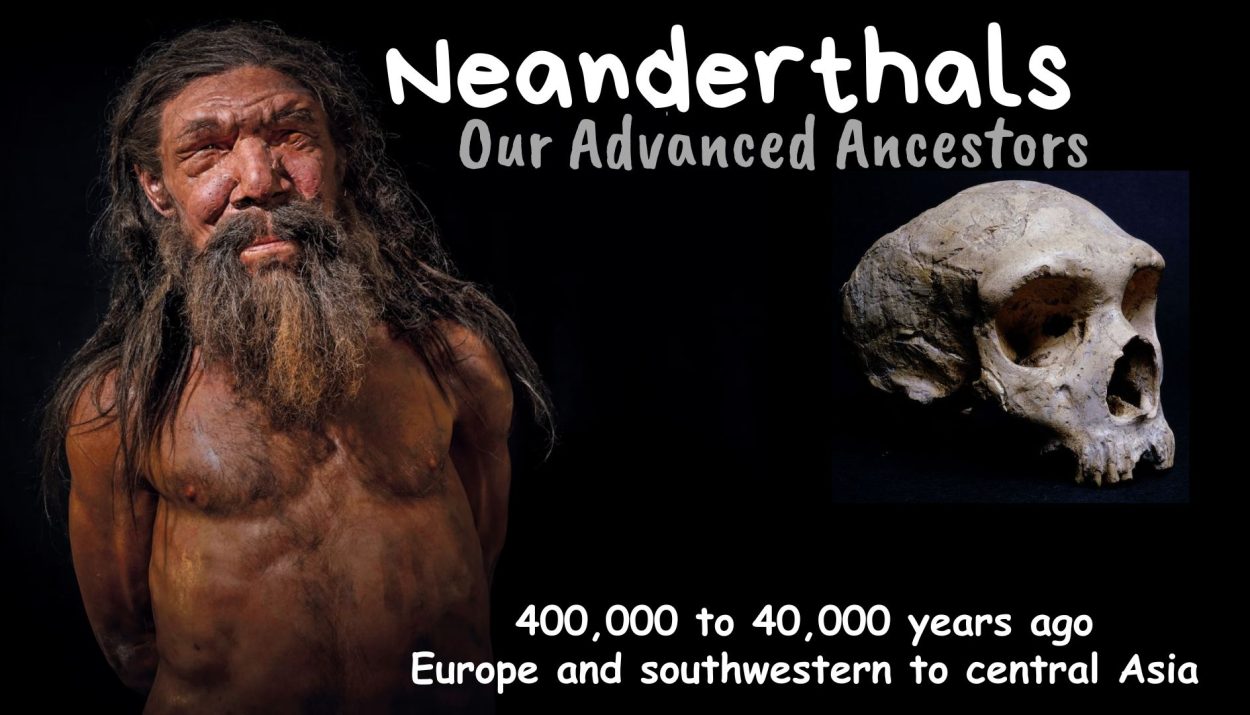Neanderthals, often misunderstood and depicted as primitive cavemen, were in fact remarkably advanced. This article will explore the fascinating world of Neanderthals, providing insights into their adaptations, culture, and enigmatic disappearance.
Neanderthals: Our Closest Relatives
Neanderthals, scientifically known as Homo neanderthalensis, are our closest relatives in the human family tree. They thrived from approximately 400,000 to 40,000 years ago, inhabiting a vast territory that extended from Europe and southwestern Asia to central Asia. Their range even extended northward to modern-day Belgium, making them the first humans to endure a cold, glacial environment.
Neanderthals, as well as a group known as Denisovans in Asia, stand out as our closest ancient human relatives. Scientific findings indicate a shared lineage, with the two species tracing their ancestry back to a common forebearer. While Neanderthals evolved in Europe and Asia, modern humans, Homo sapiens, were simultaneously developing in Africa.
Neanderthals’ fossils offer insights into how evolution shaped them to be sturdy and resilient in their harsh environment. However, their tools, art, and DNA provide compelling evidence of innovation, creativity, and social behaviour, much like modern Homo sapiens.
Adaptations for Survival
Neanderthals exhibited a remarkable mastery of their environment, demonstrating a comprehensive understanding of it. They thrived during the challenging period of the ice age, characterized by severe cold spells with temperatures plunging as low as minus 20 degrees Celsius, and substantially lower sea levels compared to the present day.
The rigorous northern climate significantly influenced the physical characteristics of Neanderthals. They had relatively short statures, with males averaging five feet, five inches and females five feet, one inch in height. Their robust frames, broad chests, sturdy torsos, and muscular limbs were all adaptations that facilitated heat generation and retention. Additionally, Neanderthals had notable features like large noses with relatively high bridges, which created nasal chambers capable of warming and humidifying the cold, dry air they inhaled in the northern regions.
Neanderthals boasted brain sizes similar to, and sometimes even larger than, modern humans. This increase in brain size likely played a pivotal role in the development of their relatively sophisticated culture. Archaeological evidence suggests that they constructed shelters, crafted clothing, and fashioned advanced tools. Remarkably, they were the first human species to craft tools from bone, representing a significant technological advancement. They also excelled in crafting tools from flint and various materials, marking a groundbreaking achievement.
Moreover, Neanderthals exhibited creativity and symbolism in their culture. They created ornamental objects and displayed symbolic gestures, including burying their dead and possibly adorning grave sites with flowers (though the flower-adorned burial ritual is still a subject of debate). Neanderthals may have even been the pioneers of some of the world’s oldest cave art, discovered in Spain, which stands as a testament to their artistic expression and capacity for symbolic representation.
The Mysterious Disappearance
Neanderthals not only endured for an impressive 300,000 years but also eventually vanished from the historical record. Sometime after 40,000 years ago, Neanderthals mysteriously disappeared from the scene. Various theories attempt to shed light on their enigmatic demise. Some scientists propose that they were either eliminated or outcompeted by modern humans, Homo sapiens, who arrived in Europe around the same time as the Neanderthals’ extinction. However, an alternative theory suggests that Neanderthals interbred with modern humans, eventually merging into the larger human population. This interbreeding may explain why most individuals of European or Asian descent carry 1% to 2% Neanderthal DNA in their genetic makeup.
Another crucial factor contributing to the Neanderthals’ fate could have been rapid and substantial climate shifts. These abrupt temperature changes had consequences for the plants and animals that were vital to the Neanderthals’ survival. Faced with these formidable challenges, only those who displayed exceptional resourcefulness and adaptability could endure.
For more than 150 years, Neanderthals have been a source of fascination and puzzlement for anthropologists. The first Neanderthal fossil was discovered in Belgium in 1829, although it was only officially recognized as a Neanderthal much later. The breakthrough occurred in 1856 when quarrymen working in the Feldhofer Cave of the Neander Valley, near Düsseldorf, Germany, unearthed the first fossil acknowledged as a Neanderthal, belonging to the early human or genus Homo fossil category. This remarkable discovery led to the adoption of the name “Neanderthalensis,” derived from the region where the fossils were found, the Neander Valley.
Some notable Neanderthal fossils include:
Neanderthal 1 (also known as the Neander Valley or Feldhofer 1)
La Chapelle-aux-Saints 1
Shanidar 1
La Ferrassie 1
Amud 1
The Steinheim cranium
Conclusion
Contrary to the portrayal of brutish cavemen often depicted in popular culture, Neanderthals were an advanced species with a rich cultural heritage and unique adaptations that enabled them to thrive in a challenging environment. Delving into the world of Neanderthals not only illuminates our own evolutionary journey but also underscores the remarkable similarities we share with our ancient relatives.
References
What were Neanderthals really like—and why did they go extinct?- Nat Geo
Who were the Neanderthals?- Natural History Museum
Homo neanderthalensis– Smithsonian
Neanderthals: Our extinct human relatives- Live Science
Famous Neanderthal ‘flower burial’ debunked because pollen was left by burrowing bees- Live Science
Study casts doubt on Neanderthal ‘flower burial’ theory- The Guardian
Neanderthal classification- Britannica
Homo neanderthalensis – The Neanderthals- Australian Museum
